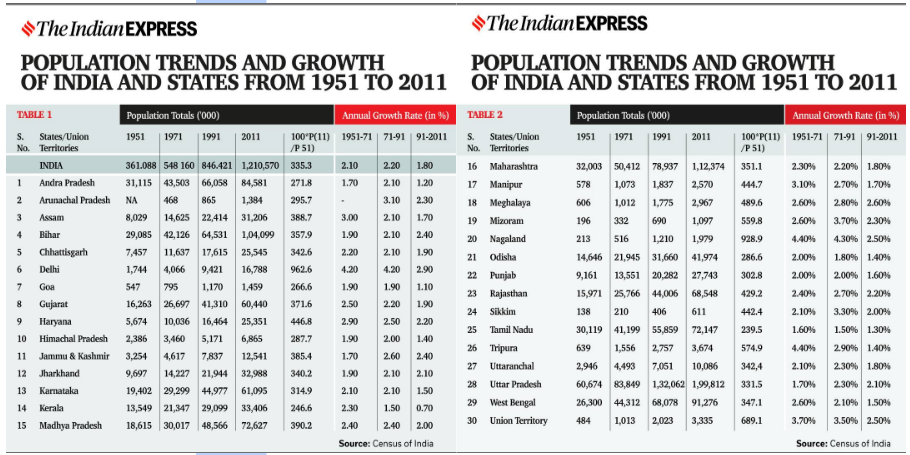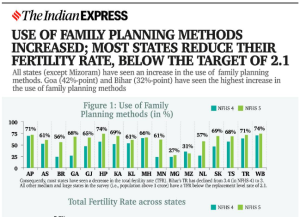Context: Recently, World Population Day was observed on 11th July.
Objective: To draw the attention of the masses to the urgency of population control and to encourage them to work together to re-establish harmony and unity with the natural environment.
Analysis of India’s Population Trend
- According to a new United Nations Population Fund (UNFPA) report, India has overtaken China to become the world’s most populous country, with more than 1.4 billion citizens, in April 2023.
- As much as 68 per cent of India’s population belongs to the 15-64 years category, and 26 per cent in the 10-24 years group, making India one of the youngest countries in the world.
- The percentage of the elderly population has been increasing from 6.8% in 1991 to 9.2% in 2016.

- Factor for slow rate of growth of population: Increased use of contraceptive methods, spacing of pregnancies, access to health care and the impetus to family planning, besides increasing wealth and education, has contributed to the rate of growth of population
- Decline in fertility rate in India: According to the Sample Registration System survey conducted yearly by the Indian government, the birth rate declined steadily from 2011 to 2020.

- As per data from the fifth and latest National Family Health Survey, for 2019-21, India’s fertility rate has dropped to 2.0, or two births per married woman.
- This is below 2.1, the replacement level of fertility, or the rate at which a generation replaces itself.
- However, the number of people in the country is still expected to continue to rise for the next few decades, hitting its peak of 1.7 billion by 2064.
Concerns Related to High Population
- Adverse economic consequence: Rampant poverty, rising inequality and widespread unemployment and underemployment.
- Sustainable development becomes a challenge as excessive resource exploitation, environmental deterioration and degradation are all directly related to overpopulation.
- Governance Challenge: Due to an increase in life expectancy and the resultant rise in the elderly population, healthcare and social security costs have increased.
- Negative social consequences:
- Low participation of women in the labour force. World Bank data shows that female labour participation in India plunged from 32 per cent in 2005 to 19 per cent in 2021.
- Low Usage of Contraceptive: About half of all Indians still don’t use modern methods of contraception. The burden of contraceptive usage falls disproportionately on women, while condom usage remains unacceptably low at less than 10 per cent.
- Loss of Identity: Fear of loss of identity of ethnic minorities and migrants may also arise from overpopulation.
- It might fuel communalism and cause rifts in the social fabric based on religion and place of origin.
- Environmental and Health Danger: Due to overpopulation and resultant environmental damage, infectious diseases evolve and spread easily. Eg: Covid-19
- Malnutrition and several illnesses are caused by a low standard of living.
- Regional Variations in Fertility: Population heavy states of Uttar Pradesh and Bihar continue to have very high fertility rates of 2.4 and 3 respectively.
Steps taken to Regulate Population in India
- First Five Year Plan: In 1952, India became the first country in the world to implement a population control programme. It emphasised the use of natural family planning devices.
- National Population Policy
| National Population Policy, 1976 |
National Population Policy, 2000 |
- · Increase the marriage age from 15-18 years for girls and from 18 to 21 years for boys.
- · Freeze the population figures at the 1971 level until the year 2001 for purposes of representation in the national parliament as well as for allocation of central assistance, devolution of taxes, and so forth to the States.
- · More attention to the education of girls.
- · nvolvement of all ministries/departments of government in the family planning program.
- · Increase in monetary compensation for sterilization.
- · Institution of group awards as incentives for various organizations and bodies representing the people at local levels.
- · More attention to research.
- · Greater use of motivational media, particularly in rural areas, for increasing acceptance of family planning.
|
- It provided a policy framework for advancing goals and priorities to various strategies in order to meet India’s reproductive and child health needs and achieve TFR by 2010.
- Aim: To address a variety of issues related to maternal health, child survival, and contraception, as well as to make reproductive health care more accessible and affordable to everyone.
- Objectives
- Temporary objective: The provision of birth control devices was included as a temporary goal. It also included the development of a health-protection framework and the recruitment of health-care workers.
- Mid-term objective: By 2010, the total fertility rate (TFR) had to be reduced to 2.1, which was the replacement level.
- Long-term objective: The goal is to achieve population stabilisation by 2045.
- The population must be stabilised at a level that is harmonious in terms of economic, social, and environmental development and protection.
|
| National Population Policy 2000: Key Achievements
·The Total Fertility Rate has declined from 2.9 in 2005 to 2.0 in 2019 (SRS).
·28 out of 36 States/UTs have already achieved the replacement level fertility of 2.1 or less.
·The Crude Birth Rate has declined from 23.8 to 20.0 from 2005 to 2018 (SRS). |
- Population control bill, 2019
- It proposed a two-child policy per couple and aimed to incentivise its adoption through educational benefits, free healthcare, better employment opportunities, home loans, and tax cuts.
- Bill was withdrawn in 2022: The policy to control and regulate the number of children violates such constitutional rights as Article 16 (equal opportunity in matters of public employment) and Article 21 (protection of life and liberty).
Government Scheme to Regulate Population
- Home Delivery of Contraceptives Scheme: It aims to mobilize ASHA workers for doorstep delivery of contraceptives.
- Ensuring Spacing at Birth Scheme: ASHA workers provide counselling to newly married couples.
- Mission Parivar Vikas: It aims to increase access to contraceptives and family planning services in certain high fertility districts.
- Clinical Outreach Teams Scheme: It provides family planning services through mobile teams from accredited organizations in far-flung areas.
- National Family Planning Indemnity Scheme: It insures its clients in case of death, complication and failure following sterilization.
Role of State Government
- Assam: Population and Women’s Empowerment Policy of Assam, 2017.
- Candidates with two children would only be eligible for government employment and existing government employees were directed to follow the two-child family norm
- Uttar Pradesh’s law commission, 2021, came up with a proposal where any person having more than two children would be barred from getting government subsidies.
Other countries’ population control laws
- China: It has taken the lead in instituting a strict one-child policy for families.
- Kenya launched family planning campaigns with the goal of matching population size to available resources.
- Russia: It is experiencing a population decline due to high mortality rates, which are likely due to factors such as drugs and alcohol.
- Article 22 of the 1969 Declaration on Social Progress and Development: It ensures that couples have the right to choose freely and responsibly the number of children they will have.
Way Forward
- Role of Government: They should focus on high-fertility districts in overpopulated states instead.
- Indian government has identified 146 high-fertility districts, and most are in the north Indian states of Bihar, Jharkhand, Madhya Pradesh, Rajasthan, and Uttar Pradesh.
- Empowerment of women: More gender equal societies have lower fertility rates and improved demographic indicators.
- NFHS 5 points out that girls who study longer have fewer children and also take up employment.
- As women become more empowered, they are also better valued as members of the society, thus reducing the felt need for a male child. The success of the Beti Bachao, Beti Padhao campaign in Haryana is a case in point.
- Capacity Development: Two-thirds of India’s total population is between the ages of 15 and 64.
- Education, skill development and creating opportunities, especially for the youth of disadvantaged sections and women, will hold the key to the country using the demographic dividend to its advantage in the next 20 years.
- Emulating the Success of Southern States: Fertility reduction was successful in five southern states defies conventional wisdom that literacy, education, and development are required for population stabilisation.
- Southern governments actively encouraged families to have only two children, followed by sterilisation.
- Male vasectomy, which is far safer than female sterilisation, should be promoted by national and state policies.
- Increase Family Planning Expenditure: India’s per-capita gross domestic product can rise an additional 13% by 2031 if family planning policies are actively prioritised.
- This can prevent 2.9 million infant deaths and 1.2 million maternal deaths and save households Rs 77,600 crore (20%) of out-of-pocket health expenditure on childbirth and child hospitalisation.
News Source: India Today
To get PDF version, Please click on "Print PDF" button.


